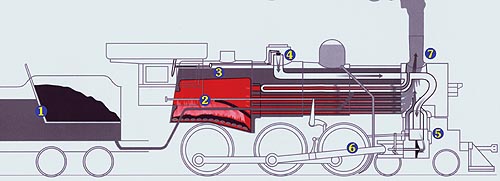
When heated, water turns to an invisible vapor known as steam. The volume of water expands as it turns to steam inside the boiler, creating a high pressure. The expansion of steam pushes the pistons that connect to the driving wheels that operate the locomotive.
- Coal or oil are the fuels used for heating the water (coal is shown in the diagram). Coal is carried in the tender of the locomotive and is hand-shoveled by the fireman into the firebox. Water is carried in the tender in a tank surrounding the coal. The water passes to the locomotive through a device called an injector.
- By spreading the coal evenly throughout the firebox, the fireman creates a level fire above the grates. Air flows up through the grates allowing the coal to burn hotter. The hot gases released from the coal flow forward through a series of flues or tubes to the front of the locomotive.
- Water surrounds the outside of the firebox. Heat from the burning coal turns water to steam, which rises to the top of the boiler. The area surrounding the firebox and tubes is the “steam generator” of the locomotive.
- Steam gathers at the steam dome, the highest point in the boiler. The engineer uses the throttle to regulate the amount of steam being sent to the pistons. A throttle lever in the cab opens and closes the throttle valve in the steam dome.
- Steam passes to the piston valves which control admission of steam to the cylinders. Once in the piston, the steam expands, pushing it in the opposite direction. At the end of the piston stroke, an exhaust port opens, allowing the steam to escape. Then the process is reversed and repeated in the opposite direction. Steam is admitted to either side of the piston so that it is always under power. A lever in the cab allows the engineer to control the action of the piston valves (direction of locomotive movement, and timing).
- The pistons push or pull the rods connected to the drive wheels, providing the force needed to move the locomotive.
- The steam is exhausted through a nozzle and up through the smokebox into the stack. This action produces the “chuff chuff” sound heard when the locomotive is moving. A draft or vacuum results, pulling air through the firebox grates to induce combustion of the coal. Both exhausted steam and coal smoke travel up through the stack.
